Locational Marginal Pricing and Daily Operation Scheduling of a Hydro-Thermal-Wind-Photovoltaic Power System Using BESS to Reduce Wind Power Curtailment
Abstract
1. Introduction
2. Materials and Methods
2.1. Hydroelectric Power Plants
2.2. Thermoelectric Power Plants Constraints
2.3. Wind Power Plants Constraints
2.4. Photovoltaic Power Plants Constraints
2.5. Battery Energy Storage Systems Constraints
2.6. Energy Balance Constraint
2.7. Transmission Limits Constraints
2.8. Objective Function
2.9. DCOPF with Losses and the LMP
2.9.1. System Losses Evaluation
2.9.2. LMP Evaluation
2.9.3. Fictitious Nodal Demand for System Losses
3. Results and Discussion
3.1. Study System
3.2. DOS and Reduction of WPC
3.3. Operating Cost
3.4. LMP
4. Conclusions
Author Contributions
Funding
Institutional Review Board Statement
Informed Consent Statement
Data Availability Statement
Conflicts of Interest
Abbreviations
| BESS | Battery Energy Storage System |
| DCOPF | DC Optimal Power Flow |
| DG | Distributed Generation |
| DOS | Daily Operation Scheduling |
| FND | Fictitious Nodal Demand |
| HPP | Hydroelectric Power Plant |
| HTWP | Hydro-Thermal-Wind-Photovoltaic |
| IPM | Interior Point Method |
| Li-NMC | Lithium Nickel Manganese Cobalt Oxides |
| LMP | Locational Marginal Pricing |
| MDF | Marginal Delivery Factor |
| MLF | Marginal Loss Factor |
| PPP | Photovoltaic Power Plant |
| PTDF | Power Transfer Distribution Factors |
| SOC | State of Charge |
| TPP | Thermoelectric Power Plants |
| WPC | Wind Power Curtailment |
| WPP | Wind Power Plant |
References
- Calif, R.; Schmitt, F.; Duran, O.M. −5/3 Kolmogorov turbulent behavior and Intermittent Sustainable Energies. In Sustainable Energy; Zobaa, A., Aleem, S.A., Afifi, S.N., Eds.; Intech: Rijeka, Croatia, 2016. [Google Scholar] [CrossRef]
- de Jong, P.; Kiperstok, A.; Sanchez, A.S.; Dargaville, R.; Torres, E. Integrating large scale wind power into the electricity grid in the Northeast of Brazil. Energy 2016, 100, 401–415. [Google Scholar] [CrossRef]
- de Jong, P.; Dargaville, R.; Silver, J.; Utembe, S.; Kiperstok, A.; Torres, E. Forecasting high proportions of wind energy supplying the Brazilian Northeast electricity grid. Energy 2017, 195, 538–555. [Google Scholar] [CrossRef]
- Boicea, V.A. Energy storage technologies: The past and the present. Proc. IEEE 2014, 11, 1777–1794. [Google Scholar] [CrossRef]
- Zhao, H.; Wu, Q.; Hu, S.; Xu, H.; Rasmussen, C.N. Review of energy storage system for wind power integration support. Appl. Energy 2015, 137, 545–553. [Google Scholar] [CrossRef]
- Farhadi, M.; Mohammed, O. Energy storage technologies for high-power applications. IEEE Trans. Ind. Appl. 2016, 52, 1953–1961. [Google Scholar] [CrossRef]
- Hu, X.; Zou, C.; Zhang, C.; Li, Y. Technological developments in batteries: A survey of principal roles, types, and management needs. IEEE Power Energy Mag. 2017, 15, 20–31. [Google Scholar] [CrossRef]
- Finardi, E.C.; Scuzziato, M.R. Hydro unit commitment and loading problem for day-ahead operation planning problem. Int. J. Electr. Power 2013, 44, 7–16. [Google Scholar] [CrossRef]
- Pereira, M.G.; Camacho, C.F.; Freitas, M.A.V.; da Silva, N.F. The renewable energy market in Brazil: Current status and potential. Renew. Sustain. Energy Rev. 2012, 16, 3786–3802. [Google Scholar] [CrossRef]
- Nogueira, L.A.H.; Cardoso, R.B.; Cavalcanti, C.Z.B.; Leonelli, P.A. Evaluation of the energy impacts of the energy efficiency law in Brazil. Energy Sustain. Dev. 2015, 24, 58–69. [Google Scholar] [CrossRef]
- Guerra, J.B.S.O.A.; Dutra, L.; Schwinden, N.B.C.; de Andrade, S.F. Future scenarios and trends in energy generation in Brazil: Supply and demand and mitigation forecasts. J. Clean. Prod. 2015, 103, 197–210. [Google Scholar]
- Dranka, E.G.; Ferreira, P. Planning for a renewable future in the Brazilian power system. Energy 2018, 164, 496–511. [Google Scholar] [CrossRef]
- Fu, Y.; Li, Z. Different Models and Properties on LMP Calculations. In Proceedings of the IEEE Power Engineering Society General Meeting, Montreal, QC, Canada, 18–22 June 2006; pp. 1–11. [Google Scholar]
- Ela, E.; Edelson, D. Participation of wind power in LMP-based energy markets. IEEE Trans. Sustain. Energy 2012, 3, 777–783. [Google Scholar] [CrossRef]
- Zhao, Z.; Wu, L. Impacts of high penetration wind generation and demand response on LMPs in day-ahead market. IEEE Trans. Smart Grid 2014, 5, 220–229. [Google Scholar] [CrossRef]
- Yan, X.; Gu, C.; Li, F.; Wang, Z. LMP-based pricing for energy storage in local market to facilitate PV penetration. IEEE Trans. Power Syst. 2018, 33, 3373–3382. [Google Scholar] [CrossRef]
- Zhong, J. Power System Economic and Market Operations; CRC Press: Boca Raton, FL, USA, 2018; pp. 136–167. [Google Scholar]
- Cotia, B.P.; Borges, C.L.T.; Diniz, A.L. Optimization of wind power generation to minimize operation costs in the daily scheduling of hydrothermal systems. Int. J. Electr. Power 2019, 113, 539–548. [Google Scholar] [CrossRef]
- Xiong, W.; Wang, Y.; Mathiesen, B.V.; Zhang, X. Case study of the constraints and potential contributions regarding wind curtailment in Northeast China. Energy 2016, 110, 55–64. [Google Scholar] [CrossRef]
- Qi, Y.; Zhang, N.; Huang, Y.; Wang, Y.; Wang, W.; Liu, C. Wind power curtailment sequence characteristic analysis. J. Eng. 2017, 2017, 1662–1665. [Google Scholar] [CrossRef]
- Li, H.; Wang, X.; Li, F.; Wang, Y.; Yu, X. A robust day-ahead electricity market clearing model considering wind power penetration. Energies 2018, 11, 1772. [Google Scholar] [CrossRef]
- Li, F.; Bo, R. DCOPF-based LMP simulation: Algorithm, comparison with ACOPF, and sensitivity. IEEE Trans. Power Syst. 2007, 22, 1475–1485. [Google Scholar] [CrossRef]
- Li, F.; Bo, R. Small Test Systems for Power System Economic Studies. In Proceedings of the IEEE Power Engineering Society General Meeting, Minneapolis, MN, USA, 25–29 July 2010; pp. 1–4. [Google Scholar]
- Li, F. Fully reference-independent LMP decomposition using reference independent loss factors. Electr. Pow. Syst. Res. 2011, 81, 1995–2004. [Google Scholar] [CrossRef]
- Boonchuay, C.; Tomsovic, K.; Li, F.; Ongsakul, W. Robust Optimization-Based DC Optimal Power Flow for Managing Wind Generation Uncertainty. In Proceedings of the AIP Conference, Las Vegas, NV, USA, 6–8 August 2012; pp. 31–35. [Google Scholar]
- Energy Research Office. Available online: https://www.epe.gov.br/pt/publicacoes-dados-abertos/publicacoes/plano-decenal-de-expansao-de-energia-2030 (accessed on 29 December 2020).
- Brazilian National System Operator. Available online: http://www.ons.org.br/Paginas/resultados-da-operacao/historico-da-operacao/ (accessed on 29 December 2020).
- de Lima, F.J.L.; Martins, F.R.; Costa, R.S.; Gonçalves, A.R.; dos Santos, A.P.P.; Pereira, E.B. The seasonal variability and trends for the surface solar irradiation in northeastern region of Brazil. Sustain. Energy Technol. Assess. 2019, 35, 335–346. [Google Scholar]
- dos Santos, S.P.; de Aquino, R.R.B.; Neto, O.N. A proposal for analysis of operating reserve requirements considering renewable sources on supergrids. Electr. Eng. 2020, 1–12. [Google Scholar] [CrossRef]
- Wood, A.J.; Wollenberg, B.F.; Sheble, G.B. Power Generation, Operation, and Control; John Wiley & Sons: New York, NY, USA, 2012; pp. 18–19. [Google Scholar]
- Hozouri, M.A.; Abbaspour, A.; Fotuhi-Firuzabad, M.; Moeini-Aghtaie, M. On the use of pumped storage for wind energy maximization in transmission-constrained power systems. IEEE Trans. Power Syst. 2014, 30, 1017–1025. [Google Scholar] [CrossRef]
- Zheng, L.; Hu, W.; Lu, Q.; Min, Y. Optimal energy storage system allocation and operation for improving wind power penetration. IET Gener. Transm. Dis. 2015, 9, 2672–2678. [Google Scholar] [CrossRef]
- Imani, M.H.; Niknejad, P.; Barzegaran, M.R. Implementing time-of-use demand response program in microgrid considering energy storage unit participation and different capacities of installed wind power. Electr. Power Syst. Res. 2019, 175, 1–10. [Google Scholar]
- Roques, F.; Hiroux, C.; Saguan, M. Optimal wind power deployment in Europe: A portfolio approach. Energy Policy 2010, 38, 3245–3256. [Google Scholar] [CrossRef]
- Dowds, J.; Hines, P.; Ryan, T.; Buchanan, W.; Kirby, E.; Apt, J.; Jaramillo, P. A review of large-scale wind integration studies. Renew. Sustain. Energy Rev. 2015, 49, 768–794. [Google Scholar] [CrossRef]
- Böhme, G.S.; Fadigas, E.A.; Soares, D.; Gimenes, A.L.V.; Macedo, B.C. Wind speed variability and portfolio effect: A case study in the Brazilian market. Energy 2020, 207, 1–20. [Google Scholar] [CrossRef]
- Yin, Y.; Liu, T.; He, C. Day-ahead stochastic coordinated scheduling for thermal-hydro-wind-photovoltaic systems. Energy 2019, 187, 1–13. [Google Scholar] [CrossRef]
- Lueken, R.; Apt, J. The effects of bulk electricity storage on the PJM market. Energy Syst. 2014, 5, 677–704. [Google Scholar] [CrossRef]
- Fang, X.; Li, F.; Wei, Y.; Cui, H. Strategic scheduling of energy storage for load serving entities in locational marginal pricing market. IET Gener. Transm. Dis. 2016, 10, 1258–1267. [Google Scholar] [CrossRef]
- Zhang, Y.; Rahbari-Asr, N.; Duan, J.; Chow, M. Day-ahead smart grid cooperative distributed energy scheduling with renewable and storage integration. IEEE Trans. Sustain. Energy 2016, 7, 1739–1748. [Google Scholar] [CrossRef]
- Yan, X.; Gu, C.; Wyman-Pain, H.; Li, F. Capacity share optimization for multiservice energy storage management under portfolio theory. IEEE Trans. Ind. Electron. 2019, 66, 1598–1607. [Google Scholar] [CrossRef]
- Grigg, C.; Wong, P.; Albrecht, P.; Allan, R.; Bhavaraju, M.; Billinton, R.; Chen, Q.; Fong, C.; Haddad, S.; Kuruganty, S.; et al. The IEEE Reliability Test System-1996. A report prepared by the Reliability Test System Task Force of the Application of Probability Methods Subcommittee. IEEE Trans. Power Syst. 1999, 14, 1010–1020. [Google Scholar] [CrossRef]
- Platte River Power Authority. Battery Energy Storage Technology Assessment; Platte River Power Authority: Fort Collins, CO, USA, 2017. [Google Scholar]
Short Biography of Authors
 | Roberto Felipe Andrade Menezes was born in Aracaju, Brazil, in 1988. He received the B.S. and M.Sc. degrees in Electrical Engineering from the Federal University of Sergipe, Aracaju, SE, Brazil, in 2013 and 2017, respectively. He is currently working toward a Ph.D. degree at the Federal University of Pernambuco, Recife, PE, Brazil. His main research interests are the integration of renewable energy resources, battery energy storage systems, smart grids, optimization, and electricity markets. |
 | Guilherme Delgado Soriano was born in Recife, Brazil, in 1989. He received the B.S. and M.Sc. degrees in Electrical Power Engineering from the Federal University of Pernambuco, Recife, PE, Brazil, in 2013 and 2016, respectively. He is currently working toward a Ph.D. degree at the Federal University of Pernambuco, Recife, PE, Brazil. His major interests are in the area of renewable energy, power system planning, and optimal power flow. |
 | Ronaldo Ribeiro Barbosa de Aquino was Born in Recife, Brazil, in 1962. He received the B.S. and M.Sc. degrees in Electrical Engineering from the Federal University of Pernambuco, Recife, PE, Brazil, in 1983 and 1995, respectively, and the D.Sc. degree from the Federal University of Paraiba, Brazil, in 2001. Since 1995 he has been with the Federal University of Pernambuco. He is currently an Associate Professor IV and was Head of the Department of Electrical Engineering at the Federal University of Pernambuco in the periods Feb/2001–Feb/2005 and Oct/2014–Oct/2018. His research interests are with applications of artificial intelligence tools such as artificial neural networks, adaptive neuro-fuzzy inference systems, echo state network to power systems, and control systems. The applications are related to the electrical load and wind forecasting, economic load dispatch, insulators diagnosis, and industrial control systems focused on energetic efficiency. |
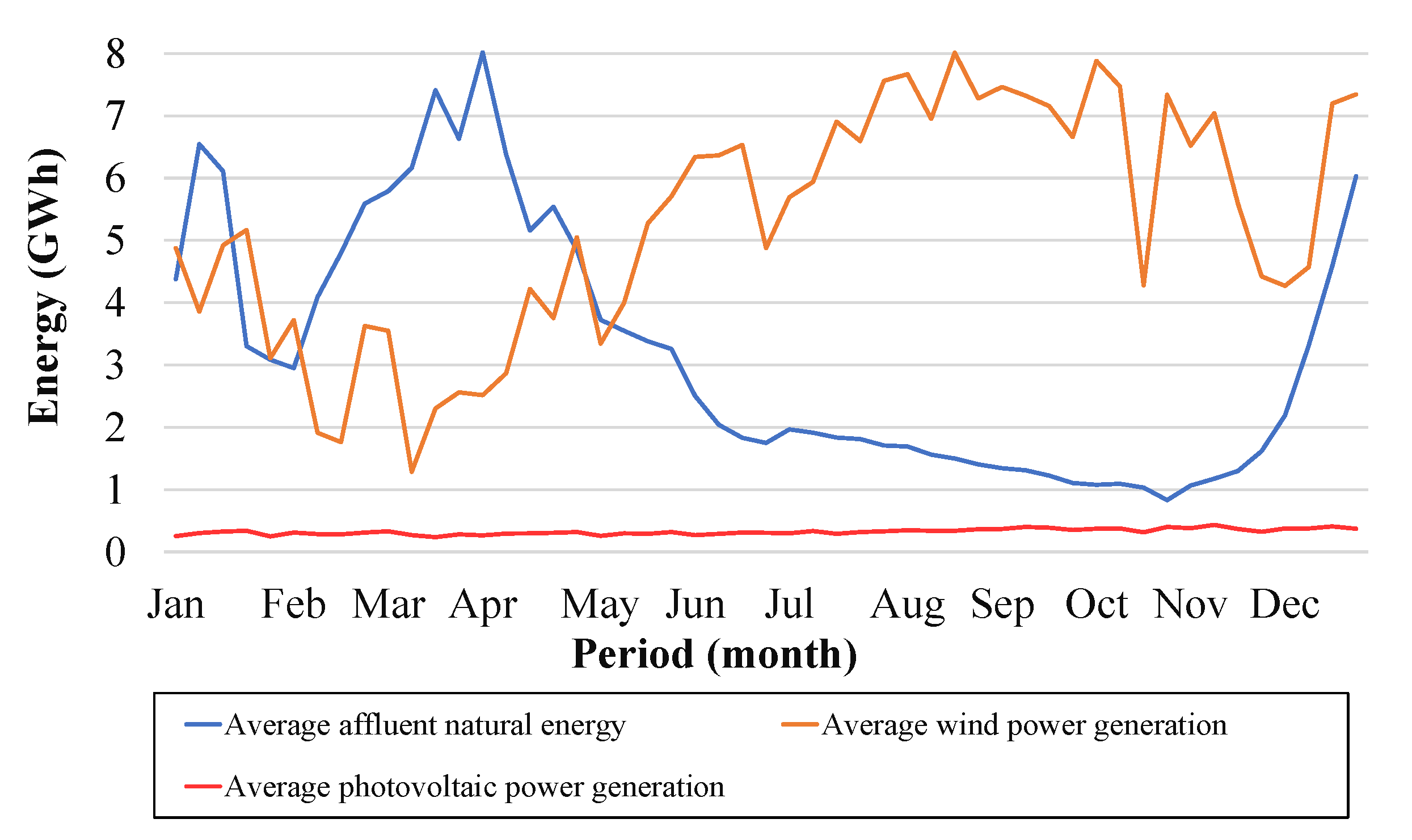
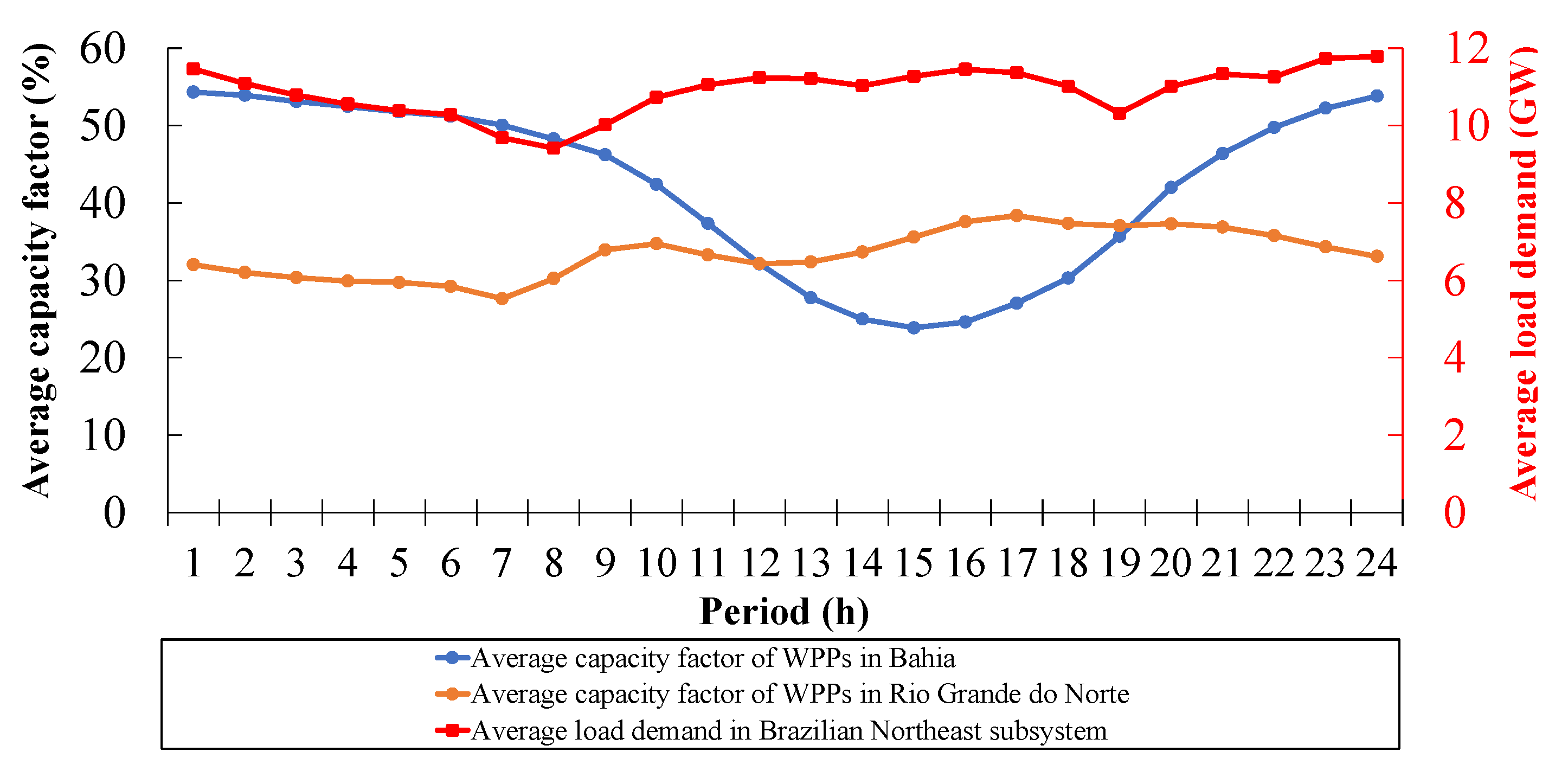
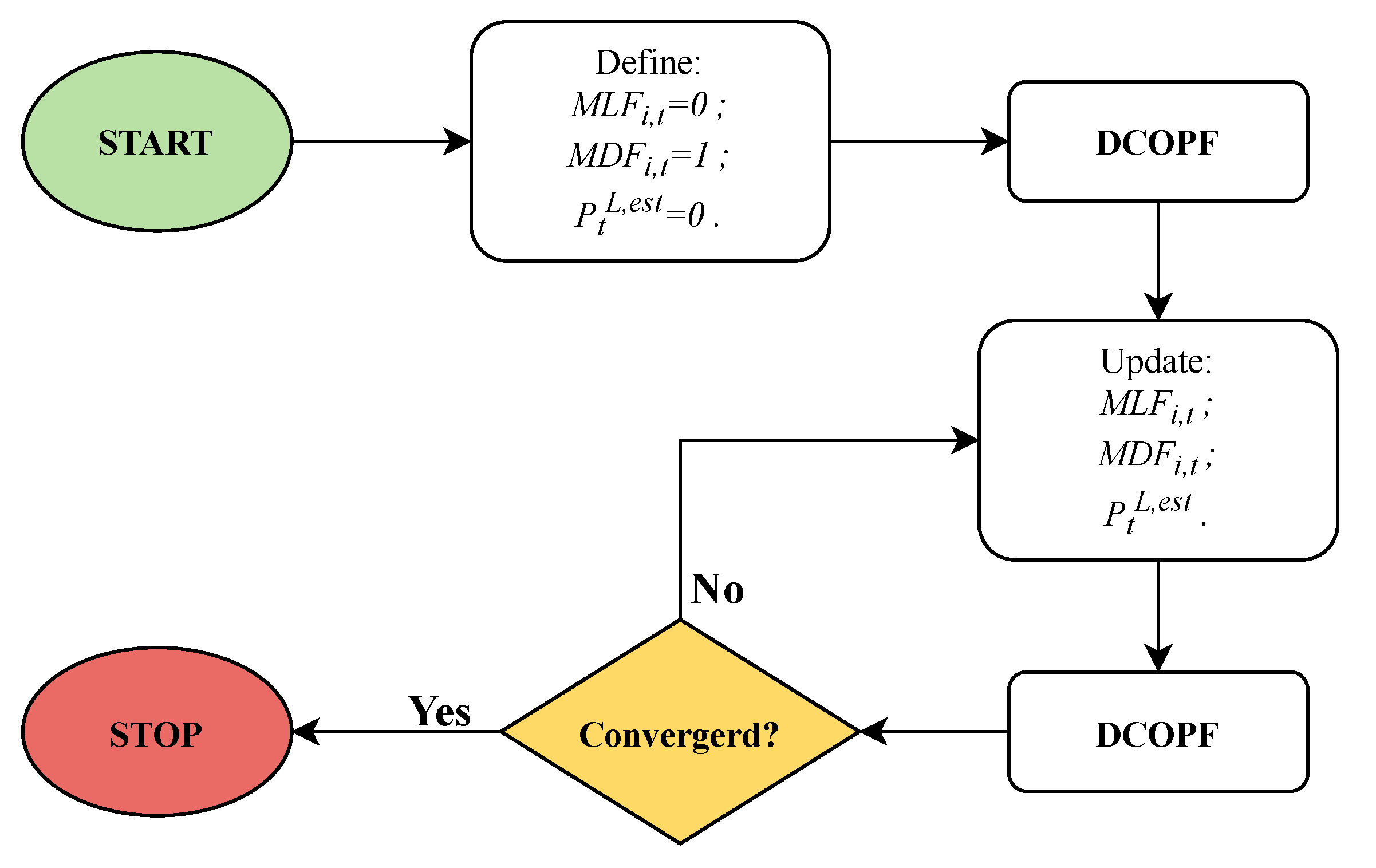
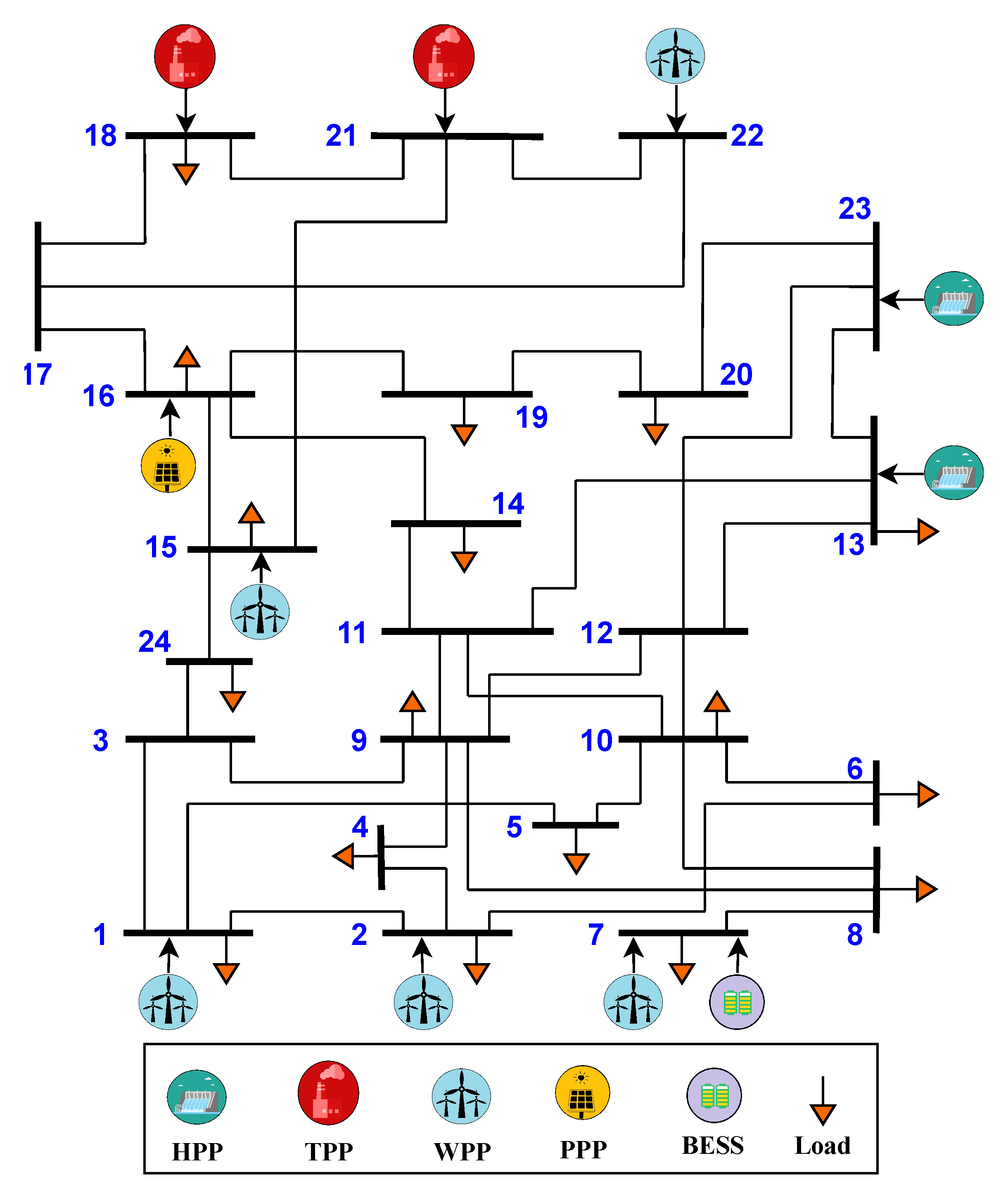
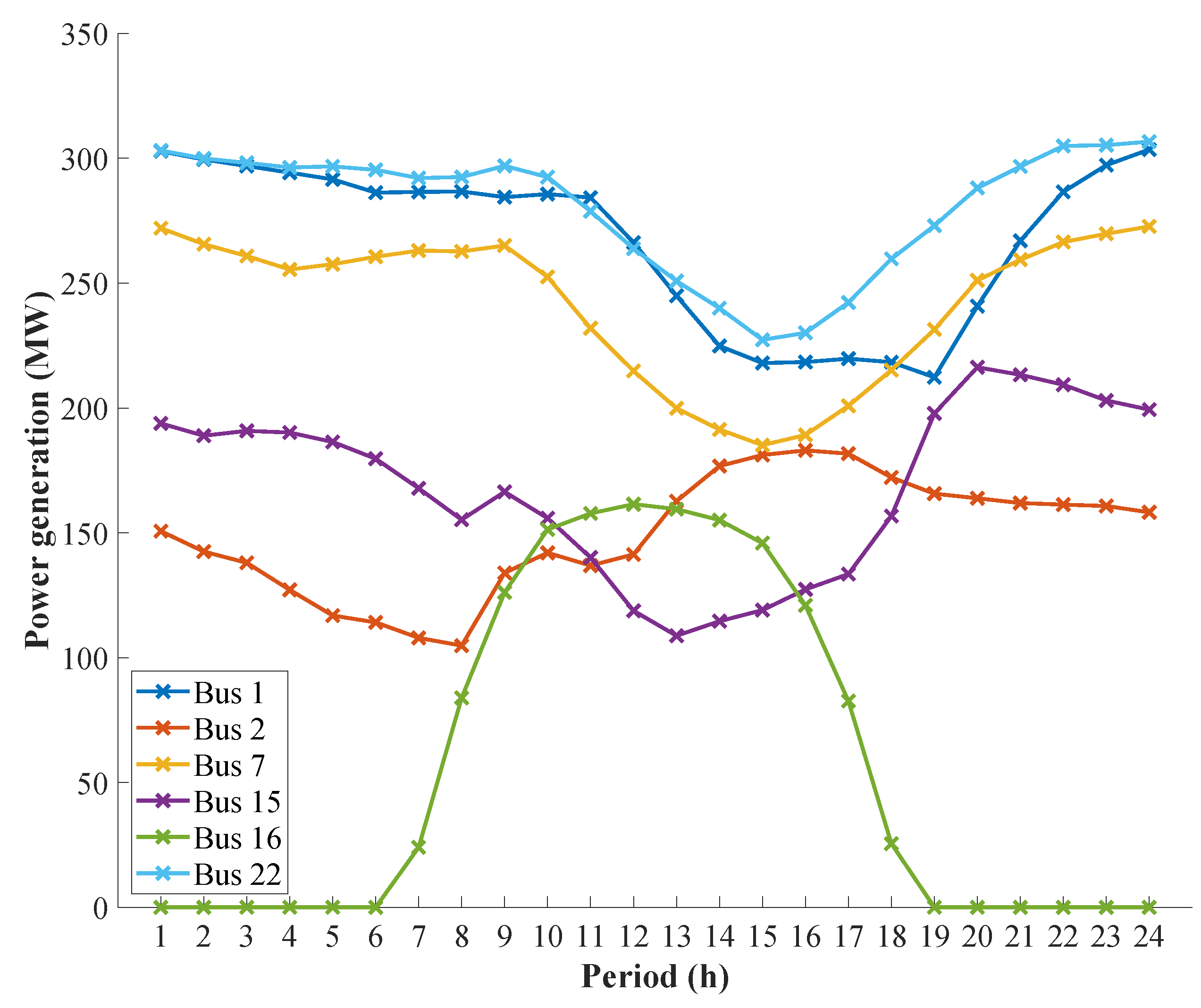
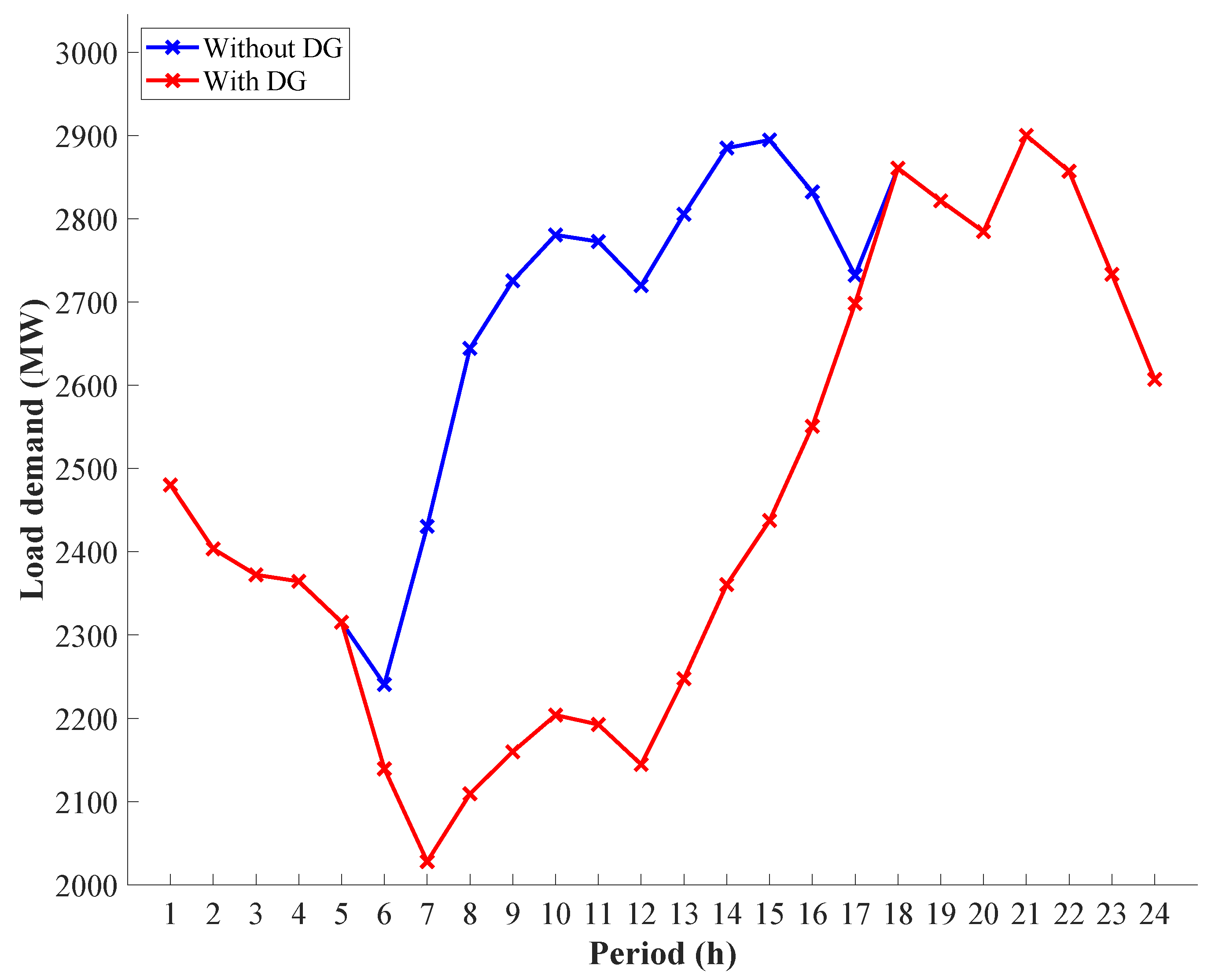
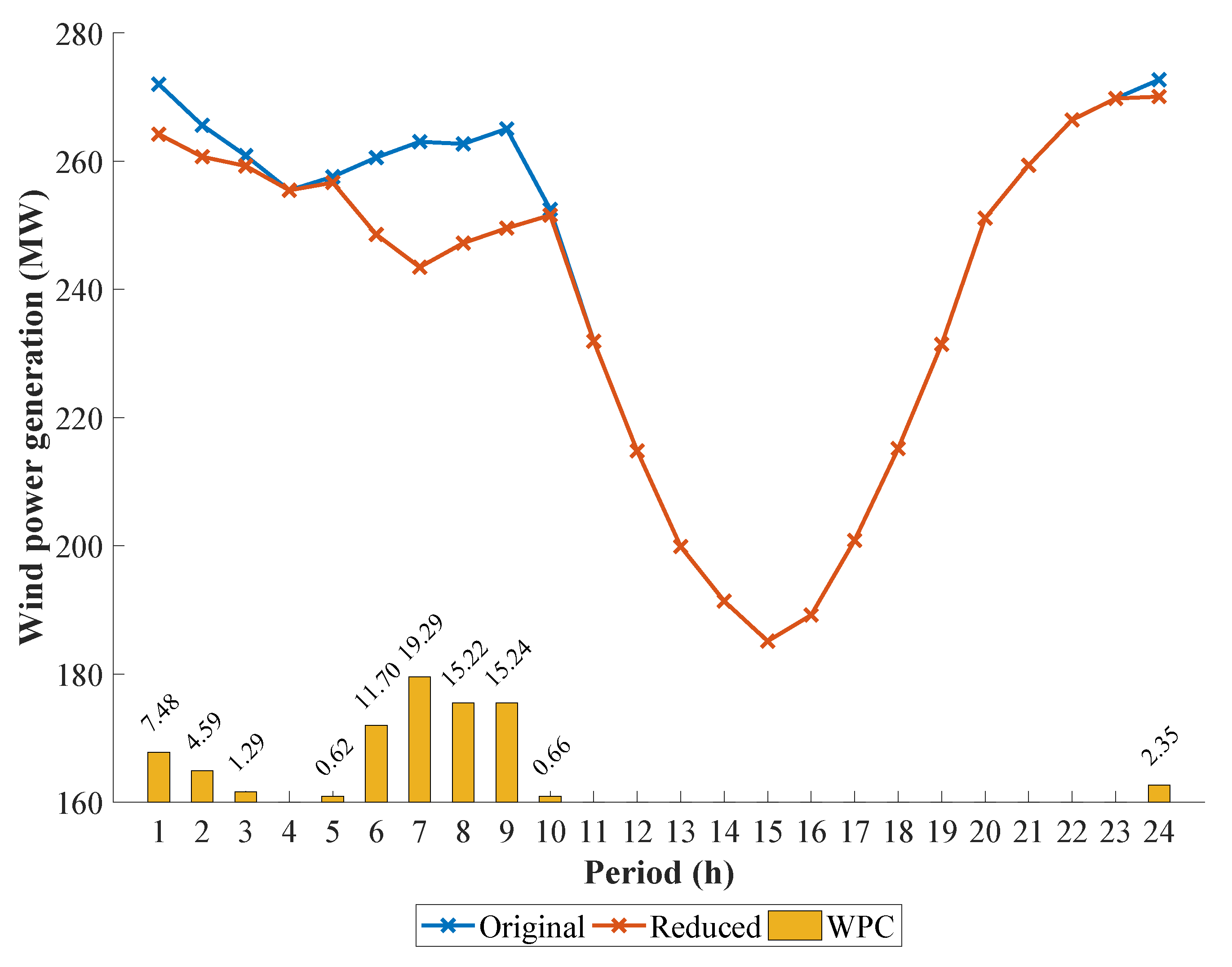
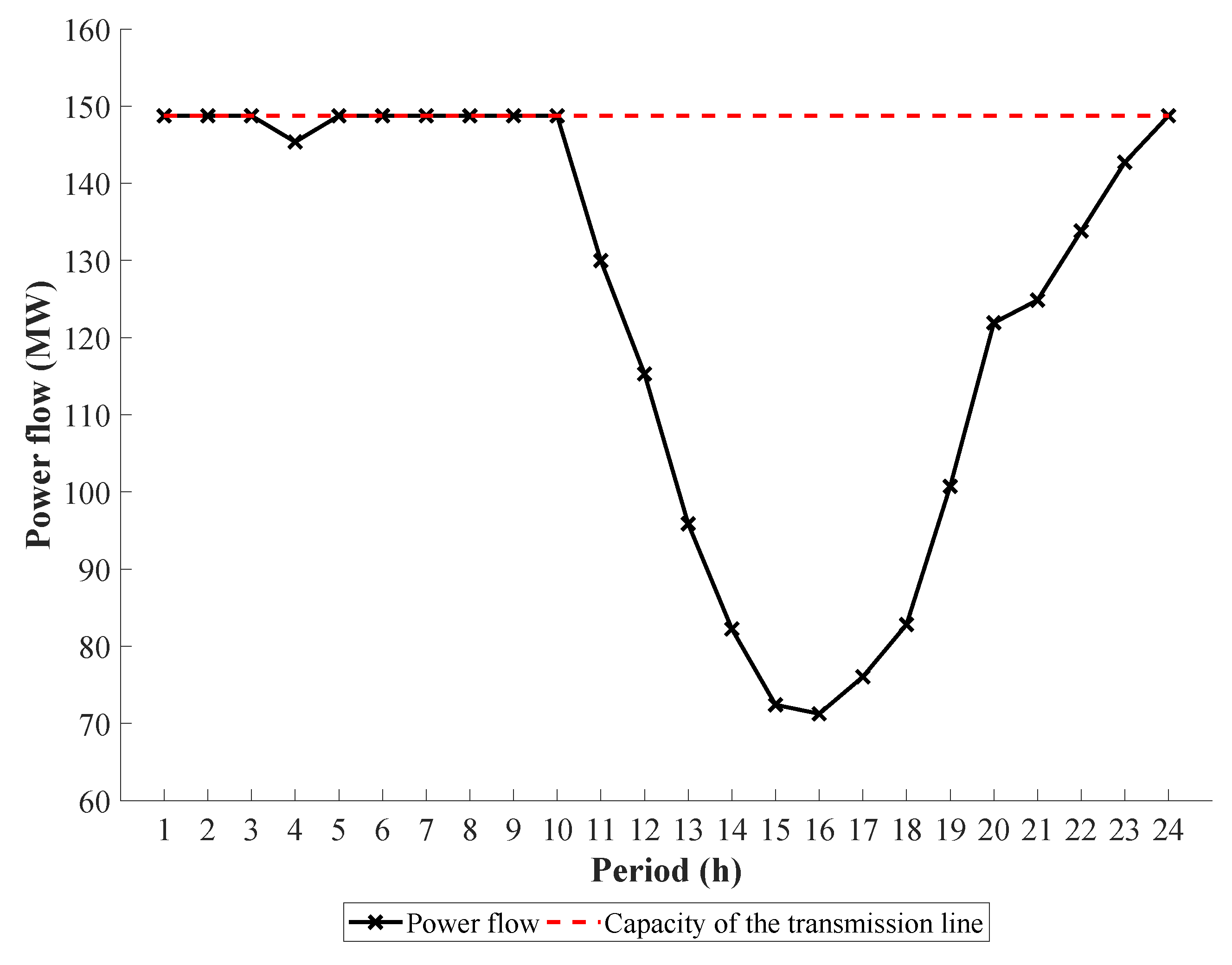
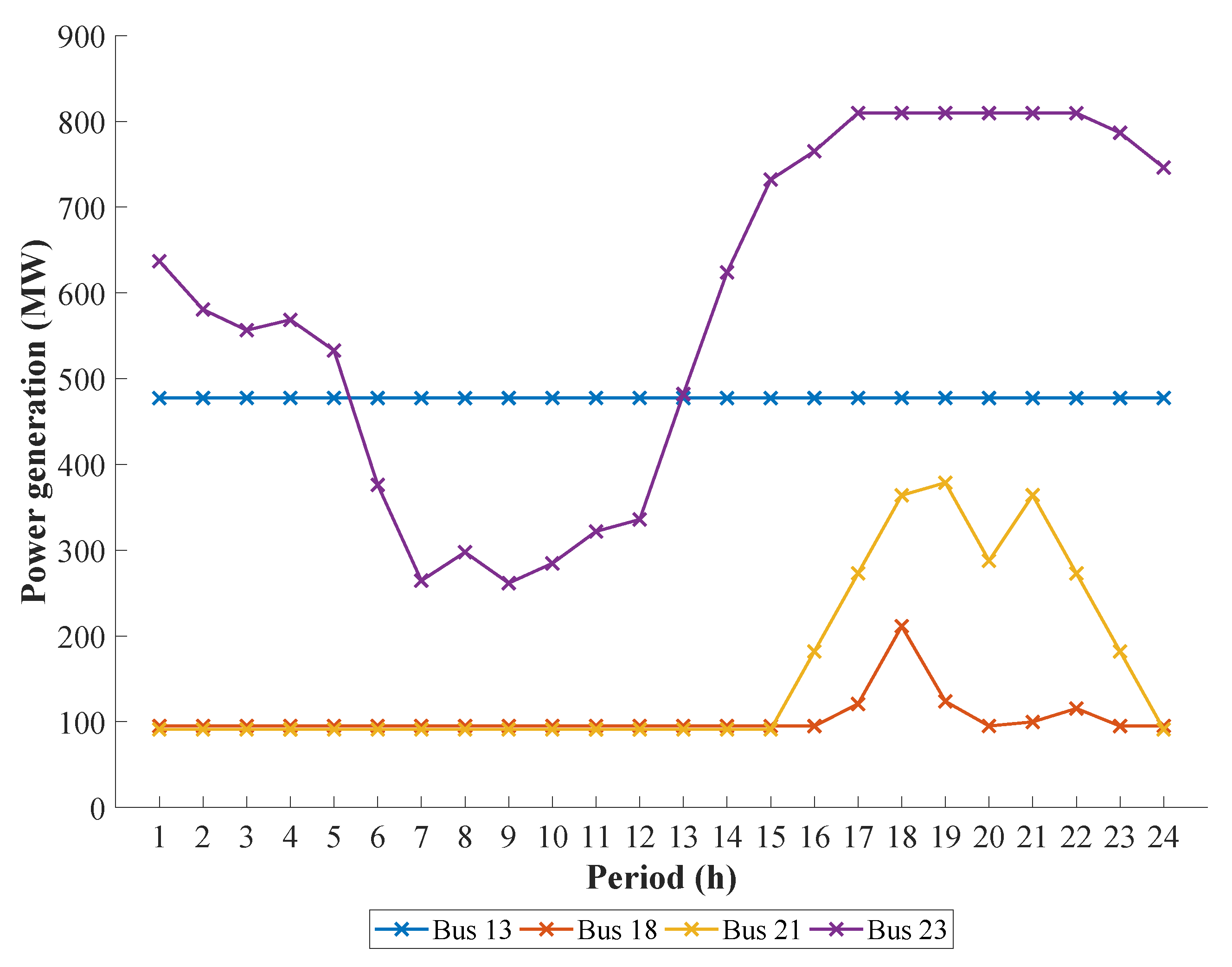


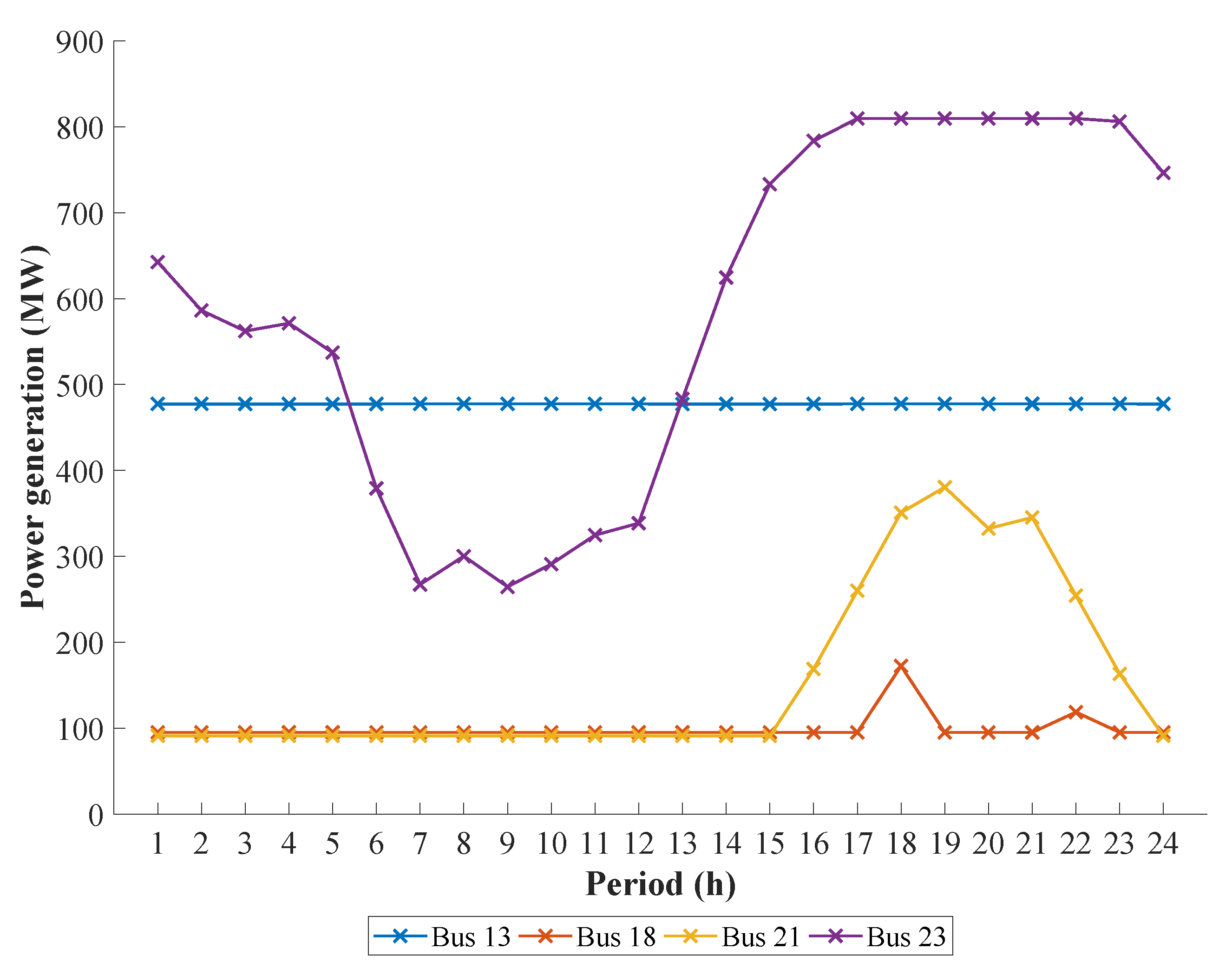
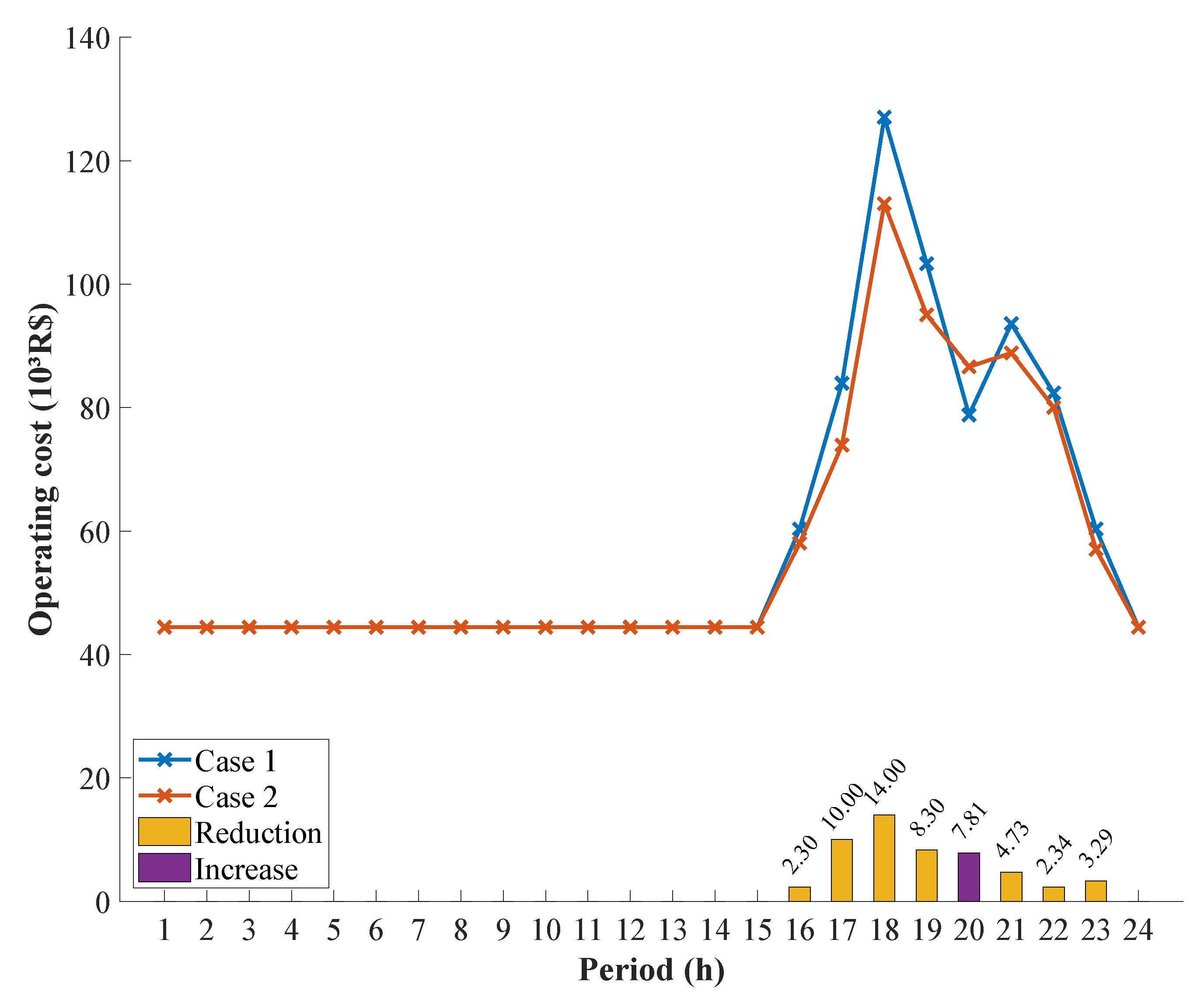
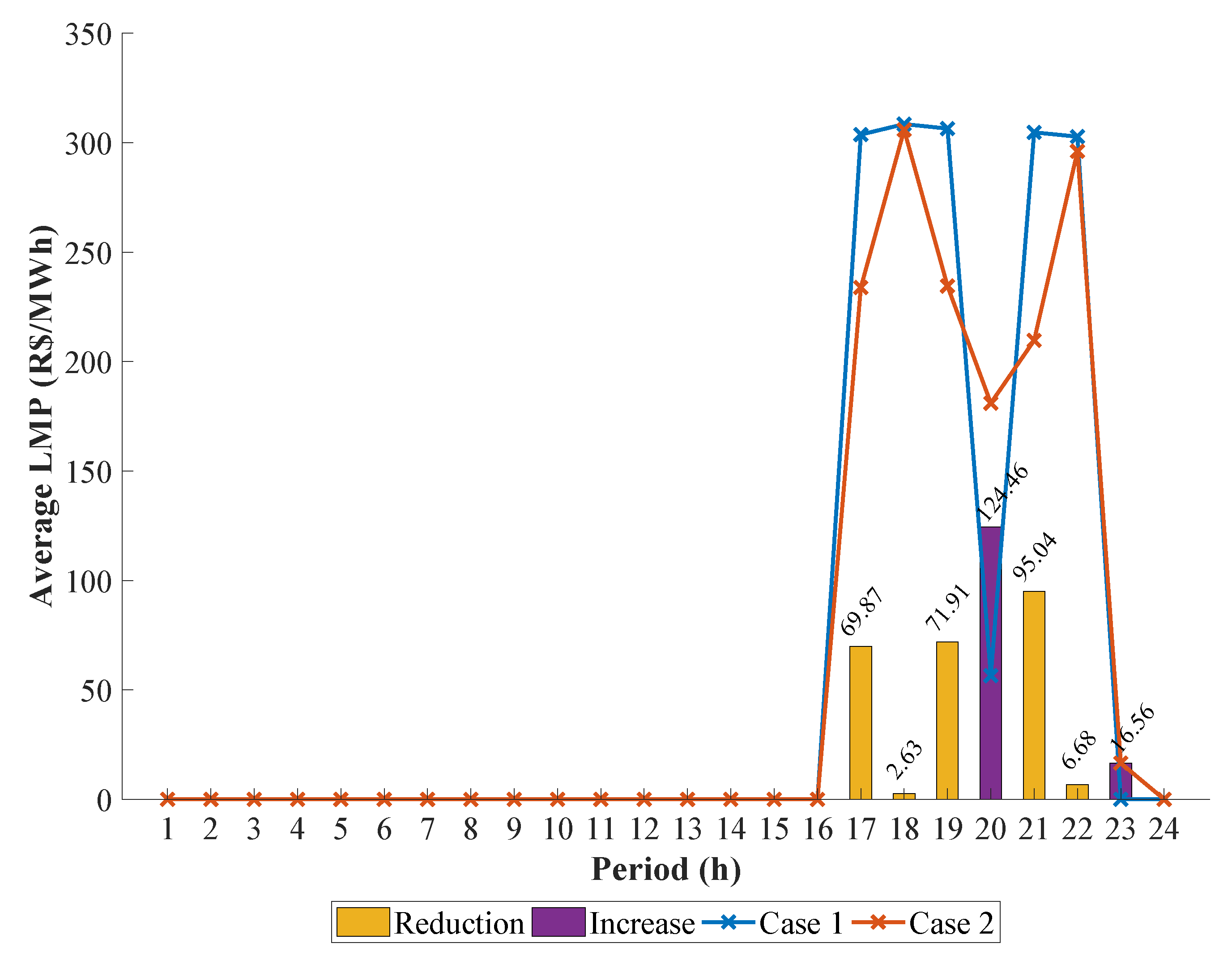
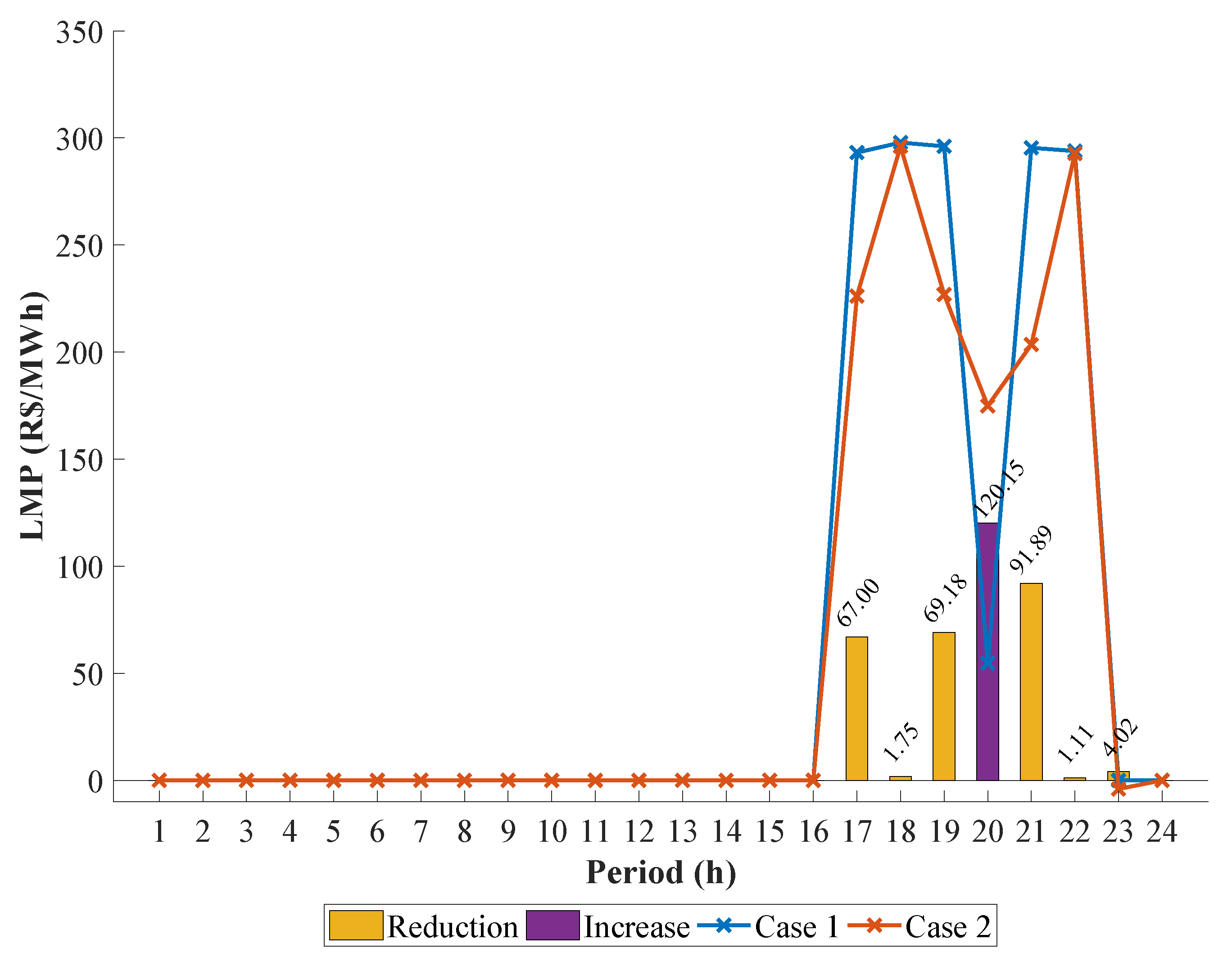
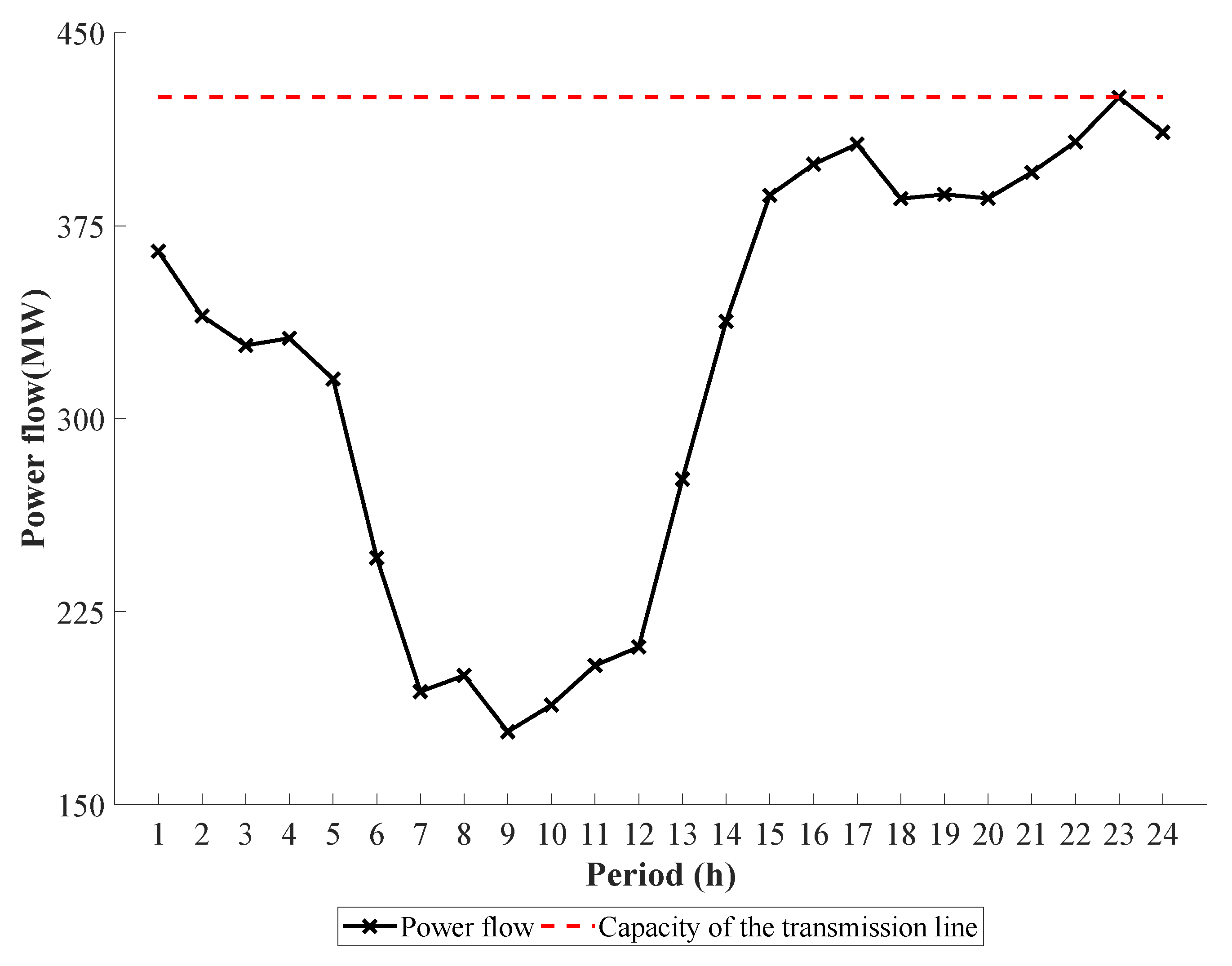
| Bus | Installed Power Capacity of the Original IEEE 24-Bus System (MW) | Installed Power Capacity of the Modified IEEE 24-Bus System (MW) |
|---|---|---|
| 1 | 192 (TPP) | 188 (WPP) |
| 2 | 192 (TPP) | 167 (WPP) |
| 7 | 300 (TPP) | 257 (WPP) |
| 13 | 591 (TPP) | 462 (HPP) |
| 15 | 215(TPP) | 200 (WPP) |
| 16 | 155 (TPP) | 145 (PPP) |
| 18 | 400 (TPP) | 381 (TPP) |
| 21 | 400 (TPP) | 365 (TPP) |
| 22 | 300 (TPP) | 291 (WPP) |
| 23 | 660 (TPP) | 794.2 (HPP) |
| Bus | Installed Power Capacity of the Modified IEEE 24-Bus System (MW) | Location (Brazilian State) |
|---|---|---|
| 1 | 203.5 (WPP) | Piauí |
| 2 | 182.5 (WPP) | Ceará |
| 7 | 272.5 (WPP) | Bahia |
| 13 | 477.5 (HPP) | Bahia |
| 15 | 215.5 (WPP) | Rio Grande do Norte |
| 16 | 160.5 (PPP) | Bahia |
| 18 | 396.5 (TPP) | Pernambuco |
| 21 | 380.5 (TPP) | Ceará |
| 22 | 306.5 (WPP) | Bahia |
| 23 | 809.7 (HPP) | Bahia |
| Bus | Source | (MW) | (MW) | (MW) | (R$/MWh) |
|---|---|---|---|---|---|
| 13 | HPP | 115.5 | 477.5 | 362 | 0 |
| 18 | TPP | 95 | 396.5 | 95 | 300 |
| 21 | TPP | 91 | 380.5 | 91 | 174.84 |
| 23 | HPP | 198.5 | 809.7 | 611.2 | 0 |
| Bus | Minimum (MW) | Maximum (MW) | Average (MW) |
|---|---|---|---|
| 1 | 212.29 | 303.5 | 267.36 |
| 2 | 104.82 | 183.02 | 149.39 |
| 7 | 185.12 | 270.36 | 238.17 |
| 15 | 108.77 | 216.3 | 168.03 |
| 16 | 0 | 161.47 | 58.09 |
| 22 | 227.28 | 306.66 | 280.46 |
| Parameter | |||||||
|---|---|---|---|---|---|---|---|
| Value | 150 MWh | 50 MW | 50 MW | 2% | 95% | 10% | 90% |
| Bus | 13 | 18 | 21 | 23 |
|---|---|---|---|---|
| Variation (MWh) | −0.05 | +3.67 | −3.96 | −2.05 |
| Case 1 | Case 2 | Variation (R$) |
|---|---|---|
| R$1,400,237.52 | R$1,363,092.32 | −37,145.20 |
Publisher’s Note: MDPI stays neutral with regard to jurisdictional claims in published maps and institutional affiliations. |
© 2021 by the authors. Licensee MDPI, Basel, Switzerland. This article is an open access article distributed under the terms and conditions of the Creative Commons Attribution (CC BY) license (http://creativecommons.org/licenses/by/4.0/).
Share and Cite
Menezes, R.F.A.; Soriano, G.D.; de Aquino, R.R.B. Locational Marginal Pricing and Daily Operation Scheduling of a Hydro-Thermal-Wind-Photovoltaic Power System Using BESS to Reduce Wind Power Curtailment. Energies 2021, 14, 1441. https://doi.org/10.3390/en14051441
Menezes RFA, Soriano GD, de Aquino RRB. Locational Marginal Pricing and Daily Operation Scheduling of a Hydro-Thermal-Wind-Photovoltaic Power System Using BESS to Reduce Wind Power Curtailment. Energies. 2021; 14(5):1441. https://doi.org/10.3390/en14051441
Chicago/Turabian StyleMenezes, Roberto Felipe Andrade, Guilherme Delgado Soriano, and Ronaldo Ribeiro Barbosa de Aquino. 2021. "Locational Marginal Pricing and Daily Operation Scheduling of a Hydro-Thermal-Wind-Photovoltaic Power System Using BESS to Reduce Wind Power Curtailment" Energies 14, no. 5: 1441. https://doi.org/10.3390/en14051441
APA StyleMenezes, R. F. A., Soriano, G. D., & de Aquino, R. R. B. (2021). Locational Marginal Pricing and Daily Operation Scheduling of a Hydro-Thermal-Wind-Photovoltaic Power System Using BESS to Reduce Wind Power Curtailment. Energies, 14(5), 1441. https://doi.org/10.3390/en14051441






